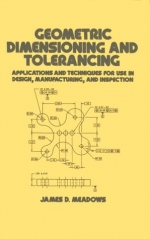Tab Article
Explaining the symbology of dimensioning and tolerancing and introducing a step-by-step system for geometric definition, this book provides examples for the application of geometric controls. The author breaks down the language of geometric product definition into a series of steps that consist of significant questions to be asked at any point in the product definition. He addresses functional requirements and manufacturing techniques, measurement, inspection, and gaging procedures. The book illustrates how symbology is best utilized, in what order it should be applied, and how each geometric control anticipates, integrates, and complements all other geometric controls on a part and in an assembly.


